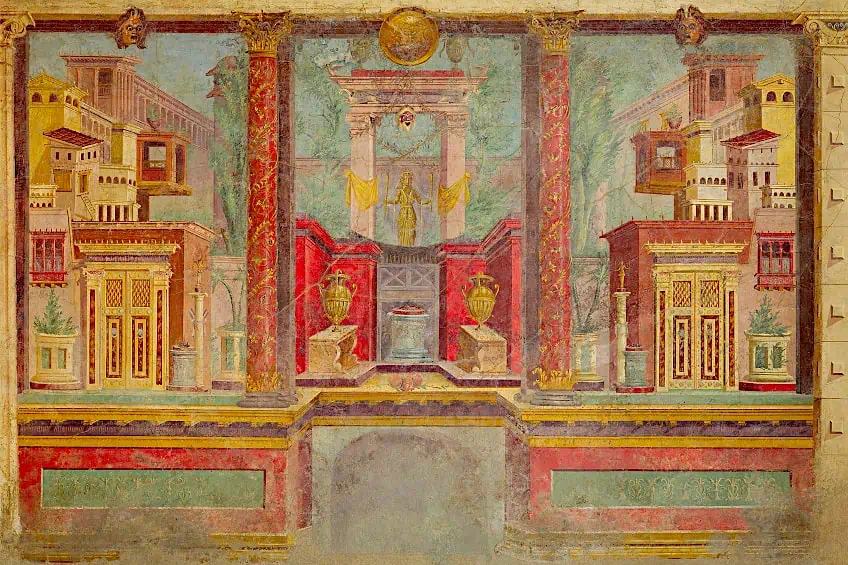Roman Art – Different Forms of Ancient Roman Artistry
In ancient Rome, arts and culture were heavily connected to Greek art, literature, mythology, and philosophy, which were only the beginning of many great innovations. Imitation may be the highest form of flattery but for early Roman artists, who are often placed in the shadows of their Greek contemporaries, imitation was simply the benchmark from which many interesting works of art were produced. Ancient Roman art is often viewed from a narrow viewpoint, which sometimes undermines the unique talents and art styles of Roman artwork. In this article, we will introduce you to the best ancient Roman paintings and Roman Empire artworks that demonstrate the numerous influences of the cultures that shaped them.
Contents
Ancient Rome: Arts and Culture
During the Roman Empire, art was often inspired by works from Greek antiquity, which does not allude to the stereotype that ancient Roman art was merely copied, rather, they were new art styles and amalgamations of the shifting culture, environment, and preferences of the time. Many Roman artists borrowed from the works of their Greek counterparts but chose to add their own spin on the different art forms and mediums. Roman sculpture and architecture progressed rapidly under the Roman Empire while birthing new developments in the applied and visual arts that speak to anything but a lack of originality.
It is also important to note that many artists who operated under Roman-run colonies came from other Greek provinces, which naturally carried over into the art of Rome. The power and reach of Rome dominated the world for several centuries through its tactical war efforts and aggressive investigation into architecture, engineering, and Greek literature. Some of the most notable architectural elements that emerged under Roman leadership include the invention of concrete, the European network of bridges, roads, and the innovative dome structure. The Romans also looked up to the art and literature of the ancient Greeks as sophisticated in appearance and form, and thus did not alter the sources too much.
In Rome, art and culture were influenced by the expansion of the Roman empire and resulted in many influences from conquered lands, including Egypt and other art forms circulating in trade. Many Roman artists remained anonymous as they were not as celebrated as their Greek masters and were seen as “skilled tradesmen” who were inspired by the works of artists such as Polykleitos, Appolodorus, Phidias, and Apelles of Kos. Roman culture was more focused on the propaganda of its culture and dissemination of its status as a powerful empire with only the best of the best in all departments of life. Its approach to art can be described as utilitarian and thus aimed at the promotion of its culture as highly respectable and “civilized”.
Throughout the Roman Empire, art was focused on the realistic depictions of events and differed slightly from the Greeks’ approach to art, which emphasized an idealized view of the world around them. Below, we will examine some of the most popular art forms and mediums of the time that circulated the Roman Republic, its territories, and works under the Roman Empire. This includes sculpture, glassware, architecture, painting, and ivory carving, which you will be excited to learn more about.
Ancient Roman Sculpture
Sculpture was perhaps the most prioritized art form in Rome alongside figure painting and was heavily influenced by popular Greek sculptures and Etruscan art from central Italy, which flourished up until the 10th century. Very few sculptures from before the 1st century remain yet there are enough from the 1st century onward to revisit. Another key point to note is that by the turn of the 2nd century, the majority of sculptors operating in Rome were Greek due to slavery during the conquests of the mid-2nd century whose names were hardly included in the record books.
Sources for Roman sculptural inspiration included imported Greek statues or works originating from trade or extortion activities and were repurposed in Roman-built temples and buildings. Etruscan sculpture reached the height of its influence with terracotta effigies placed on top of sarcophagi in addition to Hellenistic styles of art after the Romans conquered the Greek lands. This was seen in many sculptures belonging to Roman patrician families who were part of the ruling class groups in ancient Rome.
Bronze Statuette; Boy in Eastern Dress (1st Century BCE)
| Artist Name | Unknown |
| Date | Mid- to late 1st century BCE |
| Medium | Bronze |
| Dimensions (cm) | 63.8 x 30.2 × 32.4 |
| Where It Is Housed | The Metropolitan Museum of Art, New York City, United States |
This jovial-looking bronze statue was the subject of debate regarding its possible origin, with theories claiming that the figure of the young boy in strange attire was most likely the child of Mark Antony and Cleopatra VII, who became the prince of Armenia following his father’s conquest in 34 BCE. The statue’s unique attire indicated that it was crafted for decorative purposes, yet the strange pyramid-shaped hat and trousers were attributed to influences from the kingdoms of Commagene and Armenia, which date to the same period of the statue’s creation.
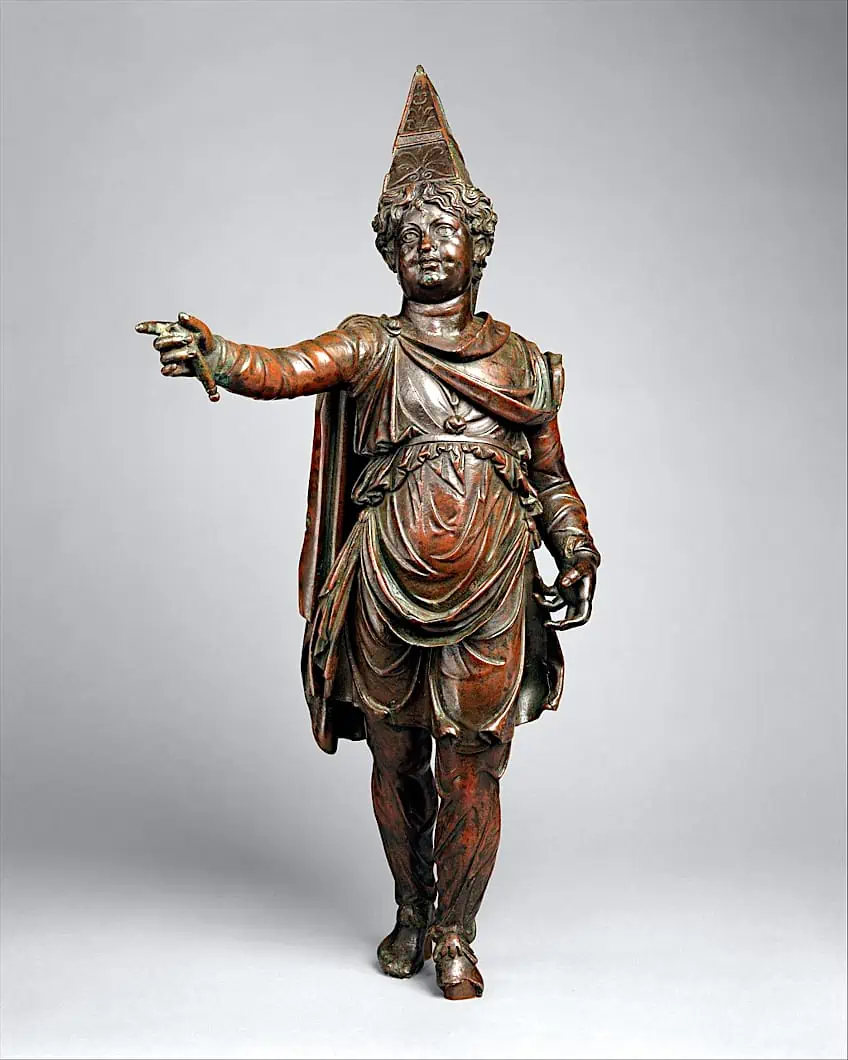
The sculpture was discovered in Egypt alongside an identical statue, which is currently housed in the Baltimore Walters Art Gallery. Other theories surrounding the young boy’s identity include the God of vegetation, Attis of Anatolian origin, or a geographical reference since there was mention of other remaining copies, which would make the statue and its copies personifications of Armenia Major and Minor.
Wealthy middle-class Roman tomb monuments also display Italian styles and contain many early forms of portraiture, which was one of the main aspects of Roman sculpture. Portraiture can also be seen in many imperial coins as well as the stern side profile and bust of Lucius Junius Brutus seen on ancient Roman bronze coins. There are not many examples of Roman artists who worked from scratch since it seemed they judged their talents beforehand in light of Greek talents. Roman sculpture tended to focus less on competing with Greek mythology and more on historical subjects, which took shape in relief sculptures on monumental columns.
Marble Statue of Eirene (c. 14 – 68 CE)
| Artist Name | Unknown Roman sculptor; copy of a Greek original credited to Kephisodotos (related to Praxiteles) |
| Date | Copy: c. 14 – 68 CE (Original: 375/374 – 360/359 BCE) |
| Medium | Marble copy of a bronze original |
| Dimensions (cm) | 177.2 (h) |
| Where It Is Housed | The Metropolitan Museum of Art, New York City, United States |
This famous Roman artwork was sculpted by an unknown Roman artist and based on the work of a Greek sculptor identified as Kephisodotos who was believed to be the uncle or father of another Greek legend, Praxiteles. The sculptures’ source of inspiration was based on a bronze statue of the daughter of Zeus, Eirene, which was once a cult in ancient Greece. The bronze original was identified as a statue housed in a marketplace called Agora of Athens and dated between 375 and 359 BCE, which is one of the most accurate dates given to a non-surviving Greek artwork.
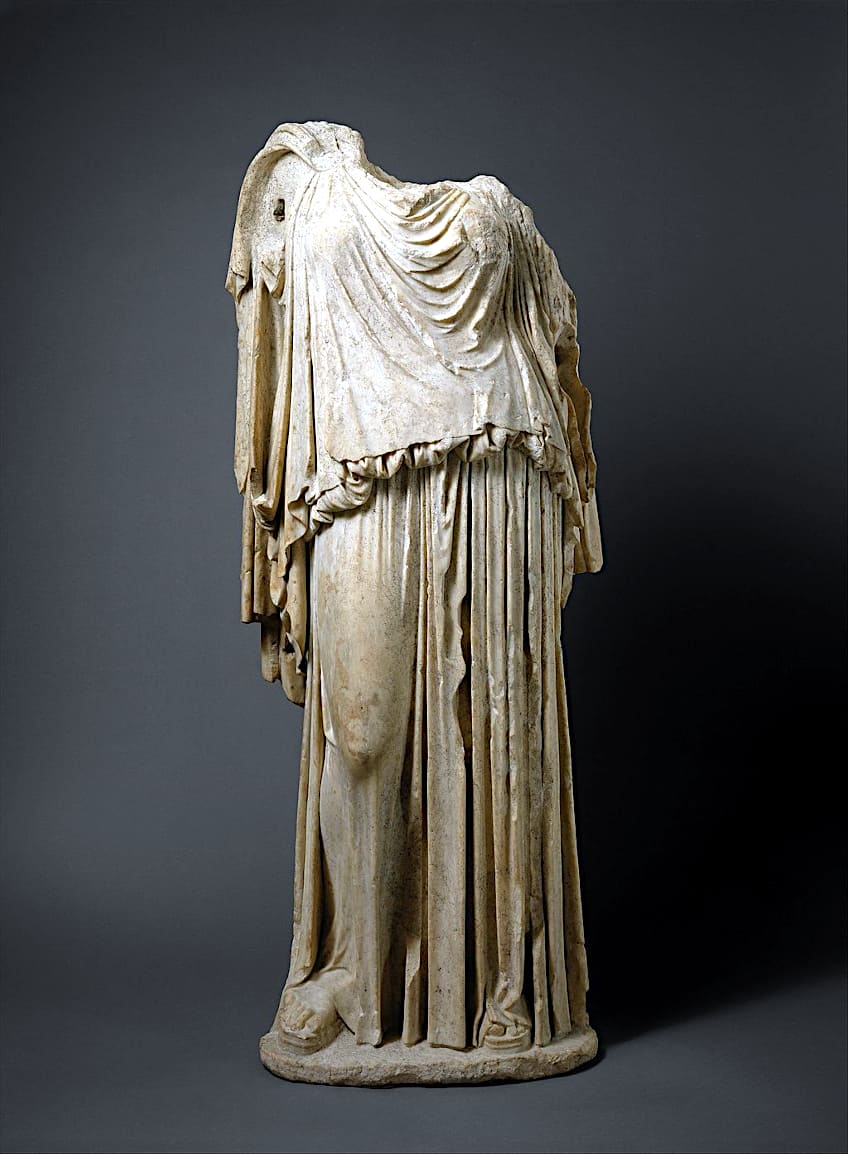
The deity Eirene was associated with the nurturing of children and the fertility of the earth and her cult was introduced to Athens around 374 BCE. Her representation was focused on her figure as a beautiful woman dressed in a himation and a scepter in her right hand. Eirene was the personification of peace and held a child called Ploutos in her left arm who was the personification of wealth. The surviving Roman copy shows the drapery of her himation, which gives the viewer a glimpse into what the original may have looked like.
Columna Traiani (c. 113 CE)
| Artist Name | Unknown |
| Date | c. 113 CE |
| Medium | Carrara marble |
| Dimensions (cm) | 350 x 370 |
| Where It Is Housed | Trajan’s Forum, Rome, Italy |
The Columna Traiani or better known as Trajan’s Column is a massive triumphal column that was constructed to commemorate the victory of emperor Trajan during the Dacian Wars. The column was built under the guidance of a Syrian architect named Appolodorus of Damascus and was completed around 113 CE. The monumental column currently stands in Trajan’s forum and contains a fascinating historical bas-relief sculpture that spirals around the column portraying war scenes between the Dacians and the Romans.

The 155 scenes on the column feature emperor Trajan about 58 times alongside 2,662 other figures in action. The helical frieze spirals 25 times and is seen as one of the most innovative sculptures of the century, which was later adopted by other emperors. Other interesting elements include a mix of different perspectives on the scenes in the frieze, which shed light on the early Roman (or Greek) sculptors and their abilities.
Additionally, the towering sculptural document spans a monumental 35 meters tall with a column composed of 20 drums of Carrara marble weighing approximately 32 tons each! Within the structure, there is also a staircase with 185 steps that leads to a viewing deck. It is a spectacular structure, which inspired many later triumphal monuments and modern architects. The top of the column was initially supposed to hold an eagle statue but was opted out for a statue of the emperor, which disappeared during the Middle Ages. By the last quarter of the 16th century, Pope Sixtus V installed a bronze statue of Saint Peter to crown the monument.
Glass and Terracotta Amphorae
Glass art in ancient Rome manifested as objects of the wealthy through amphorae and amphoriskos, which were glass vessels used as containers for the storage of oil, perfume, wine, water, or tableware décor. Over time, the access to glass amphorae widened and was soon a major technical practice of the Byzantine period. Many Roman amphorae were decorated in brightly colored paints and would either be crafted from terracotta or glass. Below, we will look at a few vivid examples of glass and terracotta amphoras in ancient Roman art history.
Terracotta Amphora (100 – 225 CE)
| Artist Name | Unknown |
| Date | 100 – 225 CE |
| Medium | Terracotta with alkaline-glaze |
| Dimensions (cm) | 25.6 |
| Where It Is Housed | The Metropolitan Museum of Art, New York City, United States |
Originating from Maarra in Syria, this terracotta amphora illustrates the decorative preference of Roman art during the 2nd century. Roman terracotta amphorae were produced body-first with the addition of rims, handles, and necks later on. Artists would then coat the interior of the vessel with resin to avoid interior permeation of liquids. The amphora also reflects the colorful eyes of Roman imperial artists through imaginative designs and can also be seen on other amphorae such as the green terracotta amphora with snake handles, also housed at the Metropolitan Museum of Art.
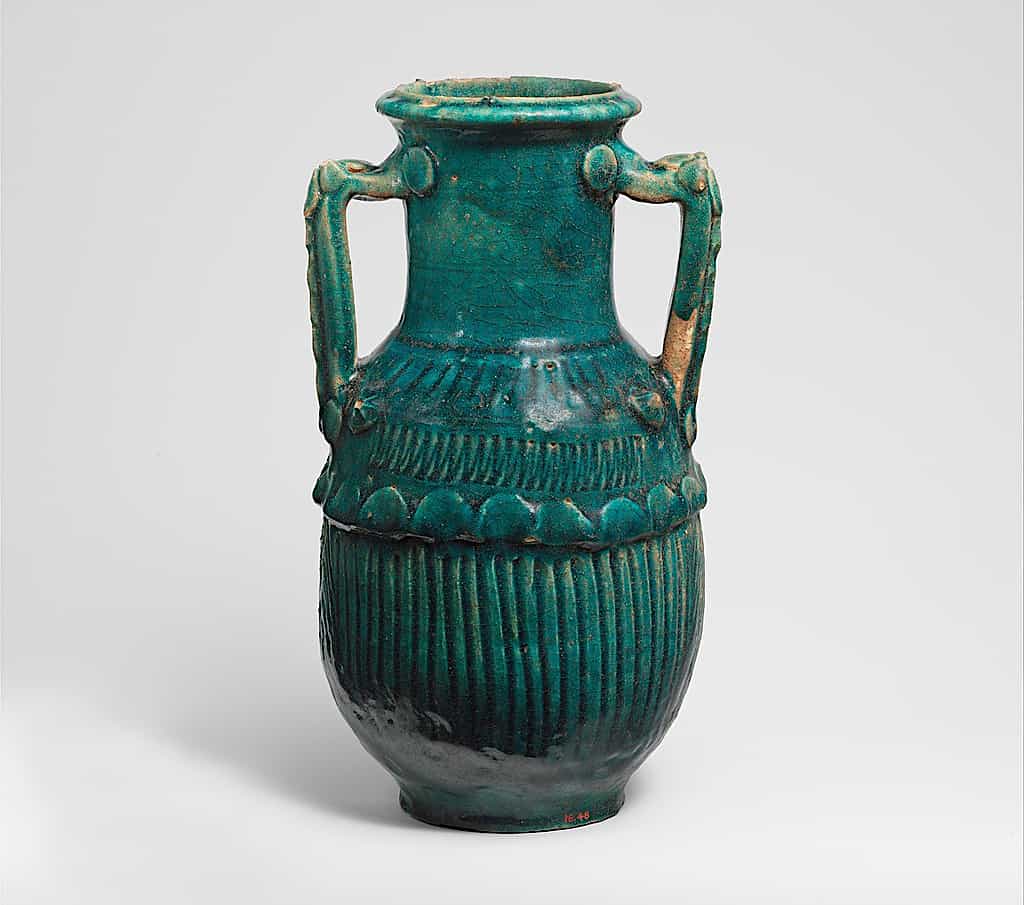
Glass Amphora with Two Handles (early 1st Century CE)
| Artist Name | Unknown |
| Date | early 1st century CE |
| Medium | Glass |
| Dimensions (cm) | 16 x 7 |
| Where It Is Housed | The Metropolitan Museum of Art, New York City, United States |
Glass amphora was a popular luxury feature of the Roman Imperial era defined by the beginning of the reign of Emperor Augustus and ending with the later period of antiquity. This golden glass amphora showcases the technical hand of an unknown artist. The Roman period saw the production of mainly utilitarian amphorae, which emerged in central Italy around the end of the 2nd century BCE. The term “amphora” was also used as a unit of measurement in ancient Rome with the volume of an amphora equating to one cubic foot.
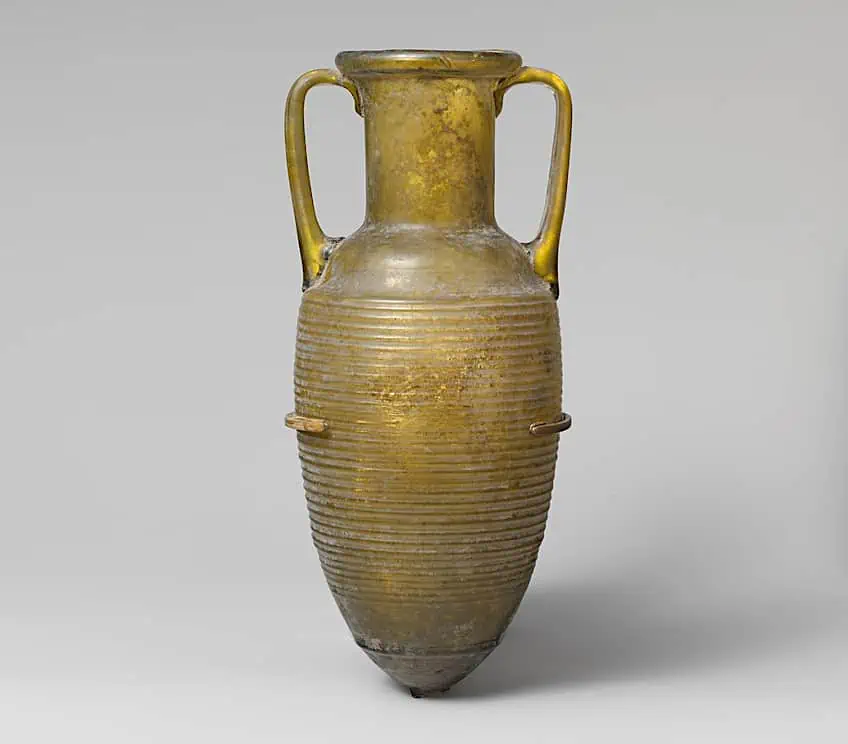
Ivory Carving
Ivory is a dentine material, which was sourced from the bones and teeth of animals for decorative art and ivory carving. The material was valued for its durability as well as its textural quality and was introduced in many artistic ways across civilizations in the Mediterranean and Asia. The cost of ivory was, of course, sadly the death of many elephants in Africa for their large tusks, which in the 19th century saw the deaths of more than 4,000 elephants due to British demands for the material. Ivory carving began as early as ancient Egypt around 5,500 BCE and was also discovered through relief sculptures on ivory slabs. The development of the medium progressed as the art forms were adopted by Syrian, Mesopotamian, Minoan, and Mycenaean sculptors.
Greek sculpture also included ivory quite regularly with few surviving artworks. One of the best examples of ivory sculpture from antiquity includes the statue of Athena Parthenos, which was a popular chryselephantine statue by Phidias. Chryselephantine sculptures combined gold and ivory to create magnificent statues for temples and the veneration of Gods. Roman ivory sculpture (100 CE – 300 CE) saw the creation of a few ivory plaques and panels, which acted as the modern version of the business card for Consuls. Below, are a few examples of decorative ivory artworks that give one a glimpse into the uses of the medium in ancient Rome.
Ivory Sandaled Foot (31 BCE – 14 CE)
| Artist Name | Unknown |
| Date | 31 BCE – 14 CE |
| Medium | Ivory |
| Dimensions (cm) | 6 x 14.3 |
| Where It Is Housed | The Metropolitan Museum of Art, New York City, United States |
Housed at the New York Metropolitan Museum of Art, this ivory foot sculpture once formed part of a small statue composed of ivory on the figure’s flesh and another material for the statue’s clothing. The sandal on the foot contains a strap with scenes that illustrate the personification of the Nile River, which alludes to the fact that the statue was probably an Egyptian deity or the Roman emperor Augustus who took control of Egypt after the defeat of Antony and Cleopatra in 31 BCE. The detail on the sandal gives one insight into the detail behind the original statue, which must have been exquisite and important.
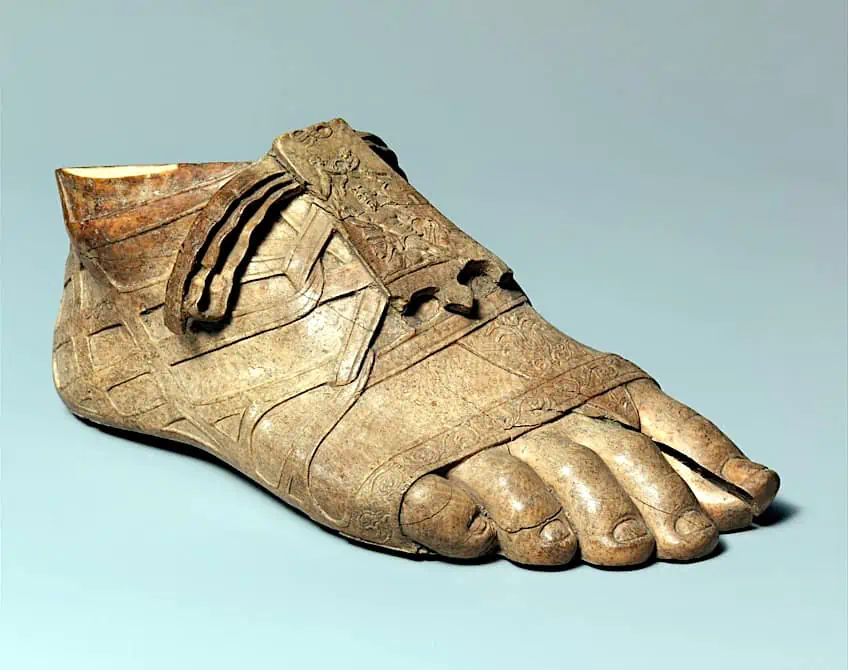
Ivory Statuette; Reclining Woman (3rd – 4th Century CE)
| Artist Name | Unknown |
| Date | 3rd – 4th century CE |
| Medium | Ivory |
| Dimensions (cm) | 3.8 x 7.3 x 2.9 |
| Where It Is Housed | The Metropolitan Museum of Art, New York City, United States |
This mini-ivory statuette was a product of late Imperial Rome and dates to between the 3rd and 4th centuries CE. Despite being a luxury material in the Roman world, ivory was used to create small decorative items as well as functional objects such as hairpins and boxes. Toward the end of the Roman Empire, the use of ivory transitioned into Christian-themed objects, which led to ivory becoming a prestigious material in Byzantine art.
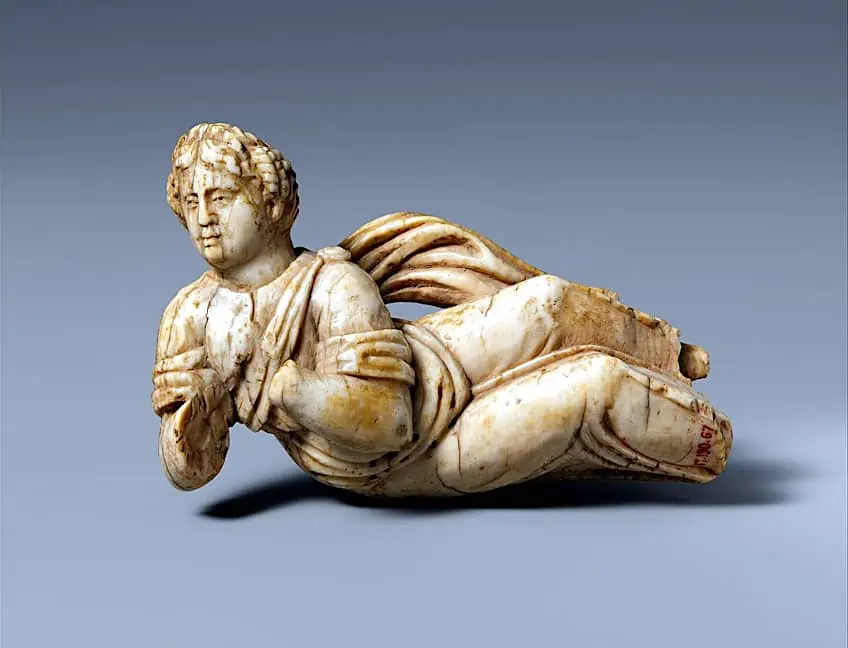
Ivory Plaque from Diptych of Consul of Constantinople Areobindus (506 CE)
| Artist Name | Unknown |
| Date | 506 CE |
| Medium | Ivory |
| Dimensions (cm) | 39 x 13 |
| Where It Is Housed | Musée de Cluny-Musée National du Moyen Âge, Paris, France |
This ivory plaque was also a reversible support plaque for writers and was carved in 506 CE for the election of the consul of Constantinople Areobindus. The tradition of an ivory plaque follows Roman and Byzantine cultural practices where new consuls would offer the plaques to their best supporters. The relief on the ivory plaque shows Areobindus with his arm raised and surrounded by his assessors. He also holds a mappa, which was a cloth used for signaling the start of circus activities. The games are carved into the ivory below him as a scene containing gladiators in a battle with wild animals.
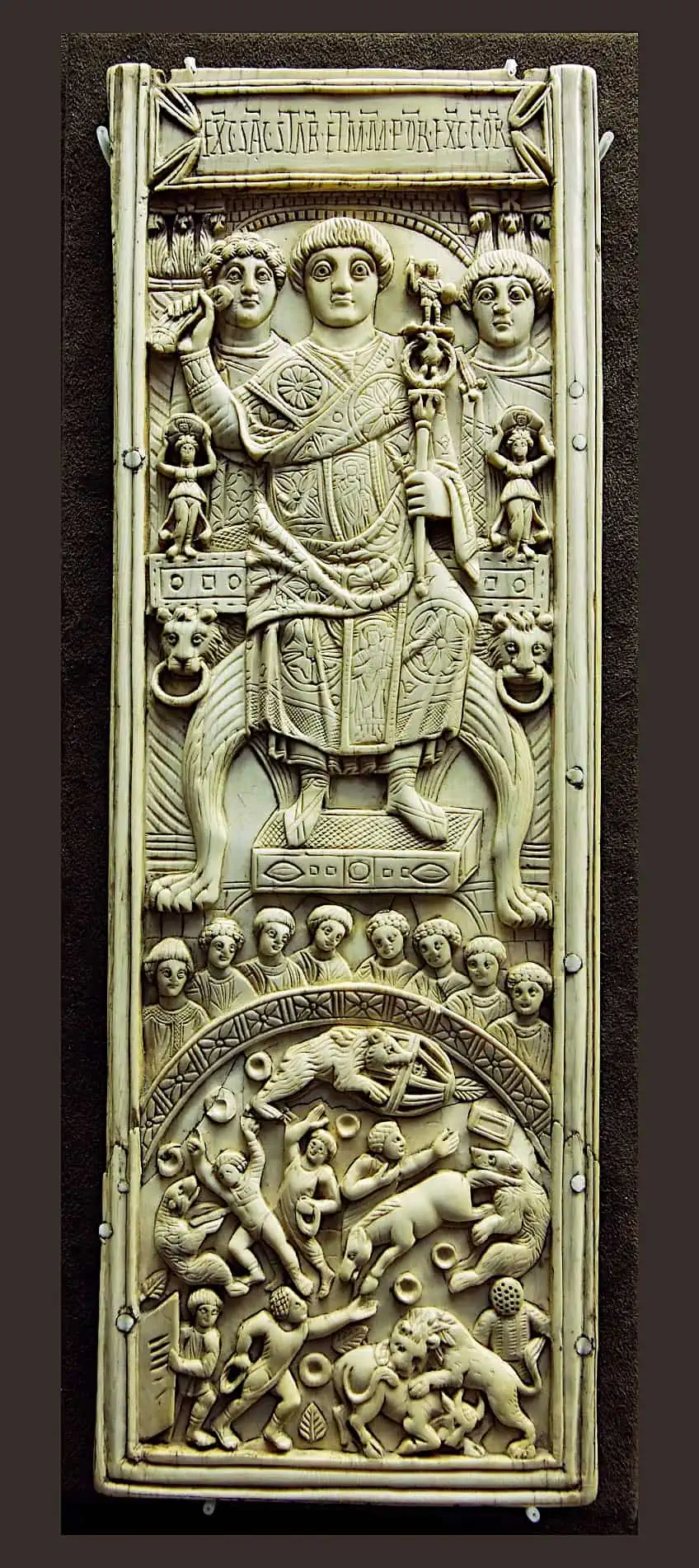
Roman Architecture
The field of architectural design was elevated by the Romans with the development of the arch in architecture as well as various techniques for large-scale urban architecture. The Romans also invented the Roman groin vault, which was an improvement of the Greek post and lintel approach and enabled the support of heavier structures. The construction of columns also decreased with the invention of the domed roof and the mass use of concrete, which sparked the Roman architectural revolution.
The institution of many monuments, temples, and palaces during the reign of emperors Hadrian and Trajan are considered the prime periods when Roman architecture thrived. Below, we will explore a few famous Roman buildings and structures that have defined Roman architecture.
Arch of Titus (c. 81 CE)
| Architect(s) | Attributed to Rabirius |
| Date | c. 81 CE |
| Medium | Pentelic marble |
| Dimensions (cm) | 154 x 135 x 475; Inner archway: 830 x 536 |
| Where It Is Housed | Via Sacra, Rome, Italy |
The Arch of Titus is one of Italy’s most treasured honorific monuments, which was built around 81 CE by the Roman emperor Domitian in commemoration of his brother’s death as well as their victory over the Jewish uprising in Judaea. The large arch was designed with fluted columns with the addition of 19th-century restoration work on the unfluted columns. The incredible artistic sculptures within the arch are one to marvel at and feature scenes from the Temple in Jerusalem, a triumphal procession, Titus as the triumphator, and the apotheosis of Titus. In 2012, it was discovered that there were also traces of yellow ochre on the menorah relief, suggesting it was once brightly decorated. The spandrels on the arch showcase winged women as the embodiments of victory. The Arch of Titus was a spring of inspiration for many architectural structures to follow, including the Arc de Triomphe (1806) in Paris and the Fusiliers’ Arch (1907) in Dublin.
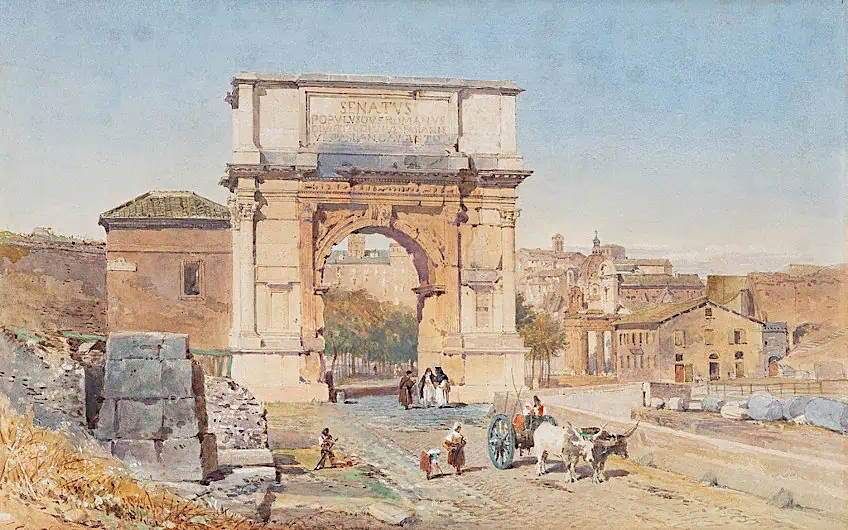
Domus Aurea (c. 64 – 68 CE)
| Architect(s) | Severus and Celer |
| Date | c. 64 – 68 CE |
| Medium | Pentelic marble |
| Dimensions (cm) | 154 x 135 x 475; Inner archway: 830 x 536 |
| Where It Is Housed | Via Sacra, Rome, Italy |
Also recognized as the Golden House, this famous architectural wonder was designed by architects Severus and Celer for the Roman emperor Nero as part of a reconstruction effort following a fire that swept through Rome around 64 CE. The wake of the destruction provided the emperor with enough room to rebuild and invest in a new villa, which was completed with all the luxurious furnishings of a palace, including fountains, courtyards, and dining rooms encapsulated in dome structures and all the finest innovations that Roman architects had to offer. The Golden House is one of the most significant structures in Roman architectural history since it reflects the playful innovation of the architects who shifted the use of concrete beyond functionality and into aesthetics.
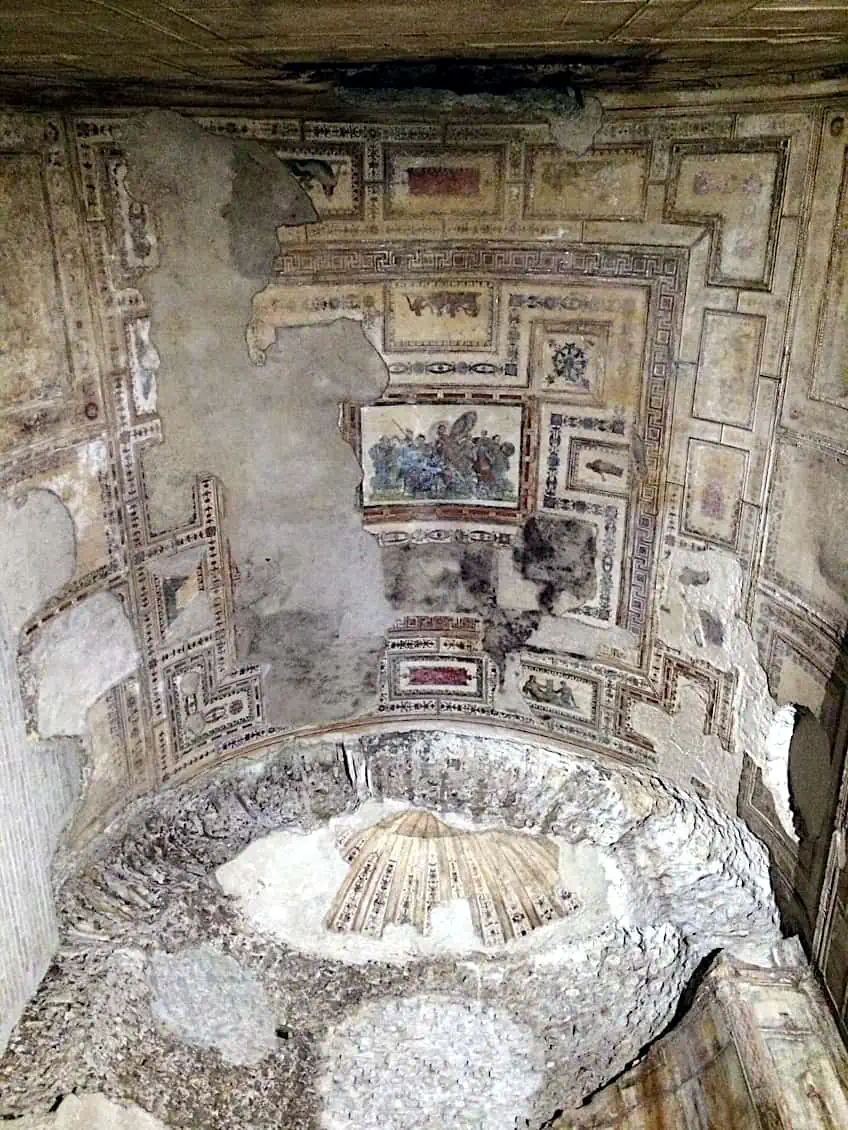
Nero had been very popular with the Roman people prior to building the Domus Aurea, but this project played a major role in his downfall. By appropriating up to half of the most desirable part of Rome for his palace, he ruined his reputation as a man of the people and gave rise to the rumor that he either had a hand in starting the fire, or was so pleased by the destruction that he played his lyre as Rome burned. His successors won over the Roman populace by destroying and burying what remained of the Golden House, constructing buildings aimed at pleasing the people, such as the Collusseum.
Ancient Roman Painting
In addition to the many copies of Greek sculptures and a few original bronze works inspired by leaders from Roman history, the Romans also painted their sculptures in a variety of colors, which matched the palettes of the pigments used in many famous ancient Roman paintings. Fresco wall paintings were among the most famous forms of art with pigments that were also used for more natural depictions of subjects.
Over time, the color from statues and paintings diminished yet the many remaining fragments from antiquity coupled with modern technology provide us with helpful information on the original visual quality of ancient Roman artwork.
Early Roman paintings were often created on wooden panels using a mixture of encaustic techniques and tempera methods to bind pigments and provide an oil paint quality to the medium. Surfaces were prepared using a layer of plaster, which was applied using a metal spatula or brush. The addition of other materials to the surface would also be used to give paintings texture, and depth, and enhance the overall aesthetic of the artwork.
Roman Painting Styles
Fresco painting was the primary approach to ancient mural art and was applied on wet plaster. August Mau, a German archaeologist outlined the four styles of Roman painting, which we have listed below for your insight!
The Masonry Style
The first style is identified as the masonry or incrustation style and was inspired by Greek palaces from the Hellenistic period in the Middle East. This art style was popular between 200 and 80 BCE and was characterized by the presence of bright colors, which enhanced the visual aesthetic of the marble.
Illusions and Immersion
Between 80 BCE and 100 CE, the development of the painting style shifted to the emergence of illusions in mural artworks. Early Roman artists began including scenes that demonstrated an illusion of a landscape, which occupied more space and eventually covered rooms and large walls. This immersive approach to art was an attempt to recontextualize the exhibition room or home and provide a more realistic experience to the viewer. The trend during this period saw a focus on the illusion of depth, shading, and perspective techniques.
The Ornamental and Imaginative Style
The third style is recognized as the period between 100 CE and 200 CE, which saw a decrease in the illusion of depth and an increase in artistic focus on decorative and ornamental elements. The preferences in this period shifted toward exotic representations with precise divisions on walls dedicated to images of architectural elements such as the grandiosity of the column and foliage for added decoration. Other features in Roman art included monochrome drawings, linear patterns, various animals, and imagined animals.
Depth and Décor
The last style is identified as the fourth style and is characterized by elements from the second and third styles. This period of ancient Roman art was documented between 200 CE and 400 CE and consisted of an emphasis on the illusion of depth with decorative elements. This time the subject matter was also elevated to include fantastical scenes from Greco-Roman mythology and still-lifes as opposed to landscapes.
Famous Roman Paintings
Now that you have an informed idea of the development of the art styles in Roman art history, we can now examine a few famous Roman paintings, which show the diversity in the visual qualities from the end of the 1st century BCE to the
Cubiculum at the Villa of P. Fannius Synistor (c. 50 – 40 BCE)
| Artist Name | Unknown |
| Date | 50 – 40 BCE |
| Medium | Fresco |
| Dimensions (cm) | 233.1 x 49.8 |
| Where It Is Housed | The Metropolitan Museum of Art, New York City, United States |
Dated between 50 BCE and 40 BCE, this famous painted room from the Villa of P. Fannius Synistor contained many dynamic murals featuring interesting townscapes that increased the visual capacity of the room. The room was once a bedroom that was destroyed, along with many other Roman villas, during the eruption of Mount Vesuvius in 79 CE. Some of the fascinating scenes include a yellow-toned monochromatic landscape as part of a still life with fruit and the figure of Hekate below a grotto that houses a small fountain. The room can be thought of as “embellished escapism” with its ornamental designs on the towering red columns and appreciation for the architecture of the land, thus, translating to an appreciation of Roman culture.

Wall Painting on Black Ground; Egyptianizing Scene (c. 1st Century BCE)
| Artist Name | Unknown |
| Date | 1st century BCE |
| Medium | Fresco |
| Dimensions (cm) | 233.1 x 49.8 |
| Where It Is Housed | The Metropolitan Museum of Art, New York City, United States |
This early imperial Roman painting is one of the most well-known ancient Roman frescoes of the 1st century, which illustrates the presence of Egyptian religious practices on the walls of the house of the Roman villa in Boscotrecase. The villa was built by the son-in-law of emperor Augustus, Agrippa, who left his villa to his son. Agrippa was married to Julia, Augustus’ daughter, who was in charge of the décor in the villa, which is today identified as one of the finest collections of Roman frescoes to date. It is believed that these wall paintings were created during the villa renovations with most paintings containing landscapes, mythological scenes, and ornamental vignettes with rich backgrounds.
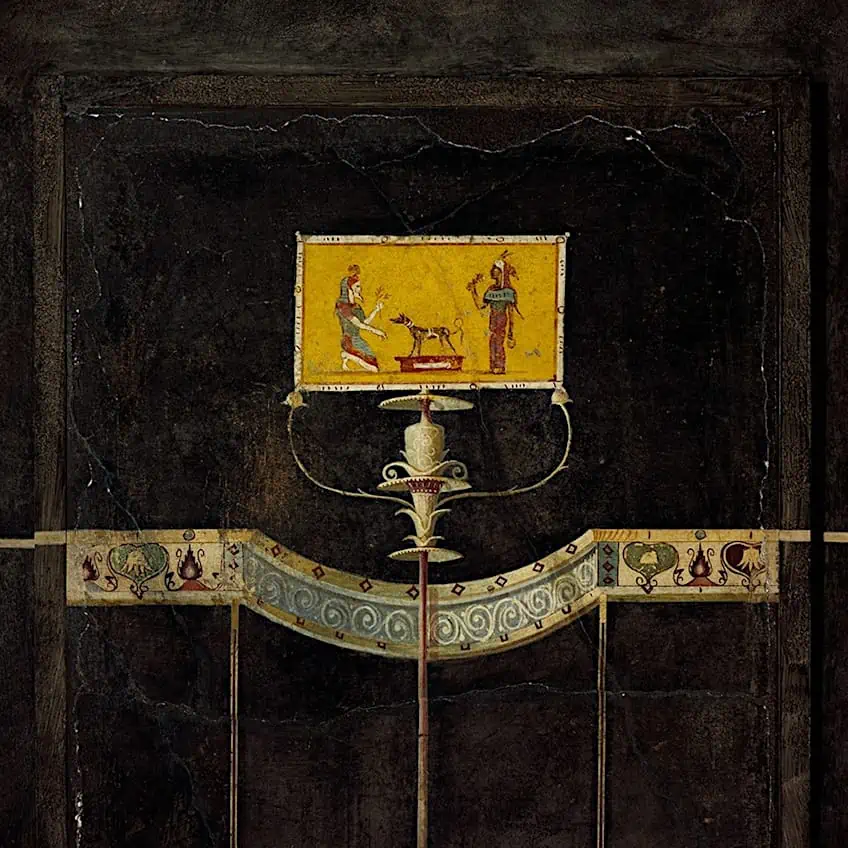
The artists behind the villa’s decoration remain unknown but are believed to have been artists from the capital. This scene in particular illustrates an Egyptian ritual performed by a priest who is seen kneeling in front of an Anubis statue. A priestess can be seen standing behind the statue. These Egyptianizing panels offer complexity to the villa’s collection through the stark backgrounds, the spiritual power of witnessing the practice, and the decorative style of the time in the third style.
An intriguing aspect of the ritual is that Anubis was associated with the practice of embalming and mummification. Priests who oversaw this process would wear masks that resembled Anubis during the process. Priestesses in ancient Egypt would lead rituals of worship or officiate sacred rituals, which is what the figure in the Boscotrecase painting appears to perform. Her headgear in the painting is also a bird while the “priest” wears a headdress similar to that of a Nemes headdress, which is a striped head cloth commonly associated with rulers of Egypt.
Polyphemus and Galatea in a Landscape (c. 1st Century BCE)
| Artist Name | Unknown |
| Date | 1st century BCE |
| Medium | Fresco |
| Dimensions (cm) | 187.33 x 119.38 |
| Where It Is Housed | The Metropolitan Museum of Art, New York City, United States |
This mythological scene was also featured in the villa at Boscotrecase and was excavated in the early 20th century by Ernesto Santini. The painting portrays the one-eyed man Polyphemus who is the son of Poseidon and Thoosa according to Greek mythology in a landscape with the nymph Galatea. The scene is inspired by the narrative of the Roman poet’s Metamorphoses (8 CE), which tells the love story of Acis and Galatea. In the poem, Acis is murdered by Polyphemus out of jealousy and Galatea magically transforms Acis into a river spirit. In the painting, one can see various scenes in the image, one where the cyclops stands on a mountainous landscape, about to hurl a rock at the invisible couple, and on the left side, facing Galatea in the aftermath of the death of her lover.

Portrait of the Boy Eutyches (100 – 150 CE)
| Artist Name | Unknown |
| Date | 100 – 150 CE |
| Medium | Encaustic on wood and paint |
| Dimensions (cm) | 38 x 19 |
| Where It Is Housed | The Metropolitan Museum of Art, New York City, United States |
A great example of the finer works of the Roman art world includes the famous Fayum mummy portraits, which are found in prestigious collections around the world, including the British Museum, the Louvre, and the Metropolitan Museum of Art. Portrait of the Boy Eutyches is one of the most famous Roman paintings created in the 2nd century by an unknown painter. The portrait depicts a young boy dressed in a Roman garment and was found in Egypt. The inscription on the boy’s tunic is Greek, which was the most common language of the Eastern Mediterranean. The boy’s name appears in the painting as Eutyches along with a suggestion for the painter’s signature, which remains unclear. The painting style is executed as part of the funerary tradition of portrait painting for mummies. This style of portraiture falls under the Fayum portraits, which are artistic products of Roman Egypt and a reflection of the multi-cultural society that occupied it.
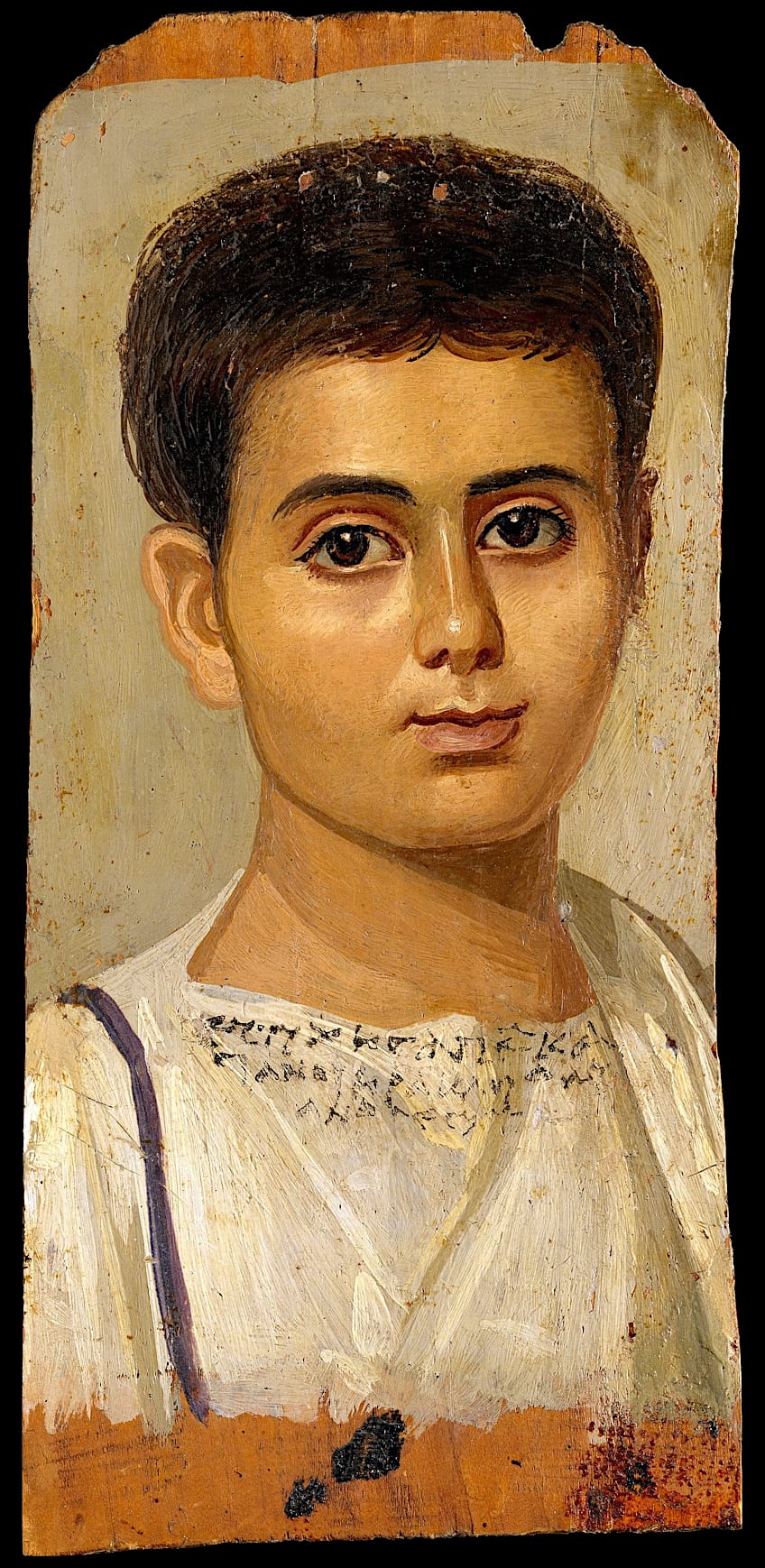
The Fayum portraits were created using an encaustic painting technique, which required artists to combine beeswax with other substances such as linseed oil or egg to create a unique texture and give the painting a sheen. This mimics the visual quality of oil paintings and helps artists add depth to the artwork. This can be seen in the shading of the boy’s face contrasted by the muted background. The paint also allowed the artist to blend the colors effortlessly for a refined appearance. The element of light for the commemoration is also seen on the boy’s face with the addition of bright white spots. His dark brown eyes also stand out against the lighter palette.
The style of the Faiyum portrait was popular in the 4th and 5th centuries and differed from traditional Egyptian painting styles. The idea of painting a person’s portrait on the face of the mummy was tied to ancient Egyptian beliefs of the afterlife. It is also crucial to understand that the population of Roman Egypt was incredibly diverse and consisted of people from Greek cities like Alexandria as well as native Egyptians and members of the population with varied ethnic backgrounds. Although the subjects of the portraits appeared to embrace Roman culture, many citizens had Greek backgrounds and likewise took solace in Egyptian beliefs. Scholarly research has also uncovered the use of Egyptian blue pigments combined with traces of red ochre in a few Fayum portraits, which boosts the shading quality of the skin and elevated the illusion of flesh.
Roman Mosaic Art
The art of mosaic creation might have first been inspired by Greek culture, but the Romans elevated the medium and process by innovating the use of tesserae, or small glass, marble, and stone pieces. This helped artists add more dimension and broaden the visual effects of mosaic art, which decorated many floors and palaces. Below, are a few famous examples of Roman mosaics that combined the fields of sculpture and painting in ancient Rome.
Alexander Mosaic (120 – 100 BCE)
| Artist Name | Philoxenus of Eretria or Aristides of Thebes (original) |
| Date | 120 – 100 BCE |
| Medium | 1.5 – 4 million tesserae |
| Dimensions (cm) | 272 x 513 |
| Where It Is Housed | National Archaeological Museum, Naples, Italy |
The Alexander Mosaic was created around 100 BCE and remains the most popular example of Roman mosaic art to date. The mosaic was crafted using between one and four million pieces of tesserae, and portrays the historical battle between Alexander the Great and the Persian king, Darius III. The battle scene is known as the Battle of Issus and is one of the best-preserved works from Pompeii. The mosaic was inspired by an ancient Greek painting and contains more than 50 figures in the scene.
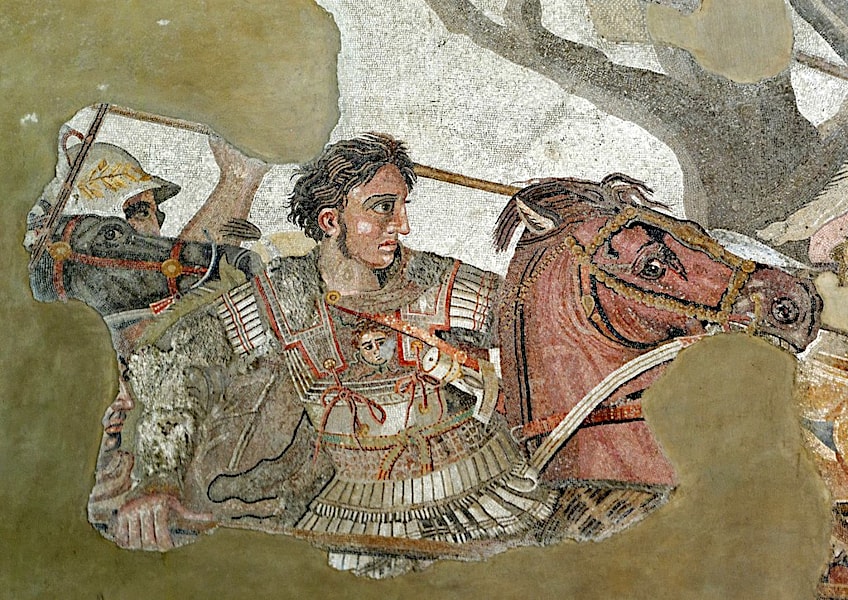
Mosaic Floor with Egyptianizing Scene (c. 130 – 150 CE)
| Artist Name | Unknown |
| Date | c. 130 – 150 CE |
| Medium | Stone and glass |
| Dimensions (cm) | 316.2 x 316.9; Center image: 118.1 x 117.5 |
| Where It Is Housed | The Metropolitan Museum of Art, New York City, United States |
Discovered at the end of the 19th century, this famous Roman mosaic illustrates an imagined Egyptian scene, which was uncovered among several other mosaics in the villa complex close to Prima Porta. Ancient Egyptians admired Rome for being a city of sophistication and a land of great wealth. The Roman mosaic was most likely created to evoke the atmosphere of Egypt while incorporating Roman motifs and geometric arrangements around the scene for traditional value.
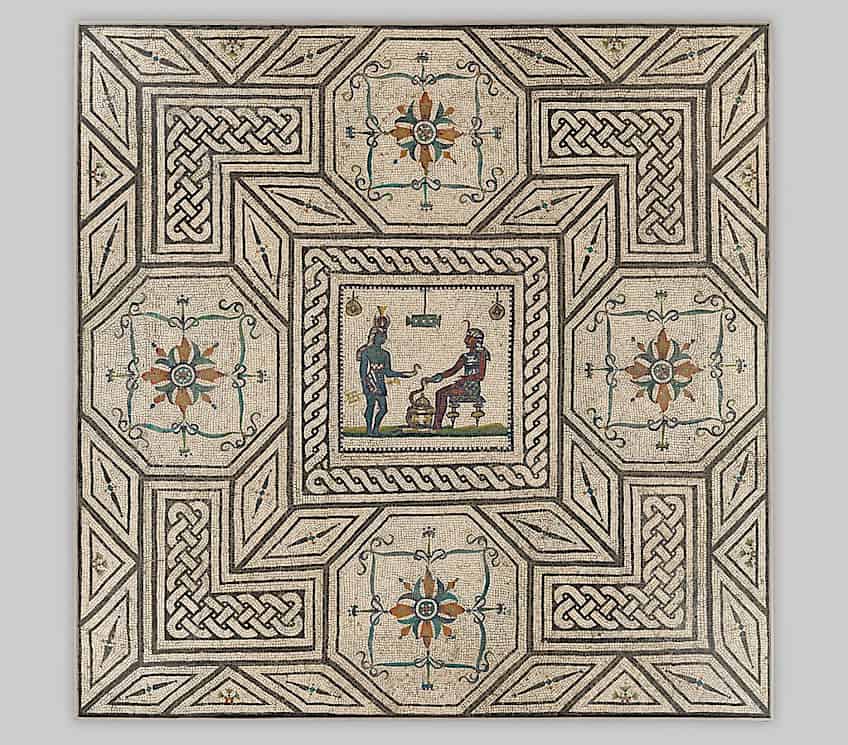
Mosaic Floor Panel (2nd Century CE)
| Artist Name | Unknown |
| Date | 2nd century CE |
| Medium | Stone, tile, and glass |
| Dimensions (cm) | 226.1 x 251.5 |
| Where It Is Housed | The Metropolitan Museum of Art, New York City, United States |
This famous 2nd-century Roman mosaic floor panel is one of the most famous mosaic artworks from the Imperial period. The panel consists of a mixture of stone, glass, and tile tesserae, which are intricately arranged to create a bust of a woman. The original mosaic was found at Daphne, which in ancient times, was a popular holiday destination. The bust of the woman serves as an emblem of abundance and prosperity and was included to enhance the atmosphere for Daphne’s visitors.

Throughout the rule of the Roman Empire, art played a significant role in capturing the many historical events and cultural preferences of the diverse populations of Roman colonies and conquered lands. The influence of warfare, architectural development, and Greek literature is evident in many Roman artworks, and is a clear indication of the potential of our ability to add a creative flair to any utilitarian practice.
Frequently Asked Questions
What Are the Characteristics of Roman Art?
The characteristics of Roman art differ across art forms and generally include the idealization of the nude figure, Classical sculpture from Greek influences, naturalistic forms, natural landscapes, townscapes, and the use of primary colors in ancient Roman painting. The characteristics of Roman art also include four primary art styles defined by incrustation, ornamental, architectural, and intricate decorative elements. Statues displayed deeper carving techniques, rigid proportions, and evidence of hierarchical scale in friezes or mosaics to signify the importance of a subject.
What Art Forms Were Practiced in Ancient Rome?
Some of the leading art forms that were practiced in ancient Rome include sculpture, relief carving, painting, mural art, mosaic art, architecture, glass art, ivory carving, coin art, and decorative art.
What Is the Significance of Ancient Roman Painting?
The significance of ancient Roman paintings is tied to their subjects, which prioritized the realistic depictions of historical scenes from warfare and life in ancient Rome. Roman art is important for understanding Roman history and the cultural preference for Greek-inspired art, as seen through mythology-themed Roman paintings.
Jordan Anthony is a Cape Town-based film photographer, curator, and arts writer. She holds a Bachelor of Art in Fine Arts from the University of the Witwatersrand, Johannesburg, where she explored themes like healing, identity, dreams, and intuitive creation in her Contemporary art practice. Jordan has collaborated with various local art institutions, including the KZNSA Gallery in Durban, the Turbine Art Fair, and the Wits Art Museum. Her photography focuses on abstract color manipulations, portraiture, candid shots, and urban landscapes. She’s intrigued by philosophy, memory, and esotericism, drawing inspiration from Surrealism, Fluxus, and ancient civilizations, as well as childhood influences and found objects. Jordan is working for artfilemagazine since 2022 and writes blog posts about art history and photography.
Learn more about Jordan Anthony and about us.
Cite this Article
Jordan, Anthony, “Roman Art – Different Forms of Ancient Roman Artistry.” artfilemagazine – Your Online Art Source. March 7, 2023. URL: https://artfilemagazine.com/roman-art/
Anthony, J. (2023, 7 March). Roman Art – Different Forms of Ancient Roman Artistry. artfilemagazine – Your Online Art Source. https://artfilemagazine.com/roman-art/
Anthony, Jordan. “Roman Art – Different Forms of Ancient Roman Artistry.” artfilemagazine – Your Online Art Source, March 7, 2023. https://artfilemagazine.com/roman-art/.


